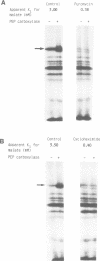Abstract
Bryophyllum fedtschenkoi is a Crassulacean acid metabolism plant whose phosphoenolpyruvate carboxylase is regulated by reversible phosphorylation in response to a circadian rhythm. A partially purified protein kinase phosphorylated phosphoenolpyruvate carboxylase in vitro with a stoichiometry approaching one per subunit and caused a concomitant 5- to 10-fold decrease in the sensitivity of the carboxylase to inhibition by malate. The sites phosphorylated in vitro were identical to those phosphorylated in intact tissue. The activity of the protein kinase was controlled in a circadian fashion. During normal diurnal cycles, kinase activity appeared between 4 and 5 h after the onset of darkness and disappeared 2----3 h before the end of darkness. Kinase activity displayed circadian oscillations in constant environmental conditions. The activity of protein phosphatase 2A, which dephosphorylates phosphoenolpyruvate carboxylase, did not oscillate. Treatment of detached leaves with the protein synthesis inhibitors puromycin and cycloheximide blocked the nocturnal appearance of the protein kinase activity, maintained phosphoenolypyruvate carboxylase in the dephosphorylated state and blocked the circadian rhythms of CO2 output that is observed in constant darkness and CO2-free air. The simplest explanation of the data is that there is a circadian rhythm in the synthesis of phosphoenolpyruvate carboxylase kinase.
Full text
PDF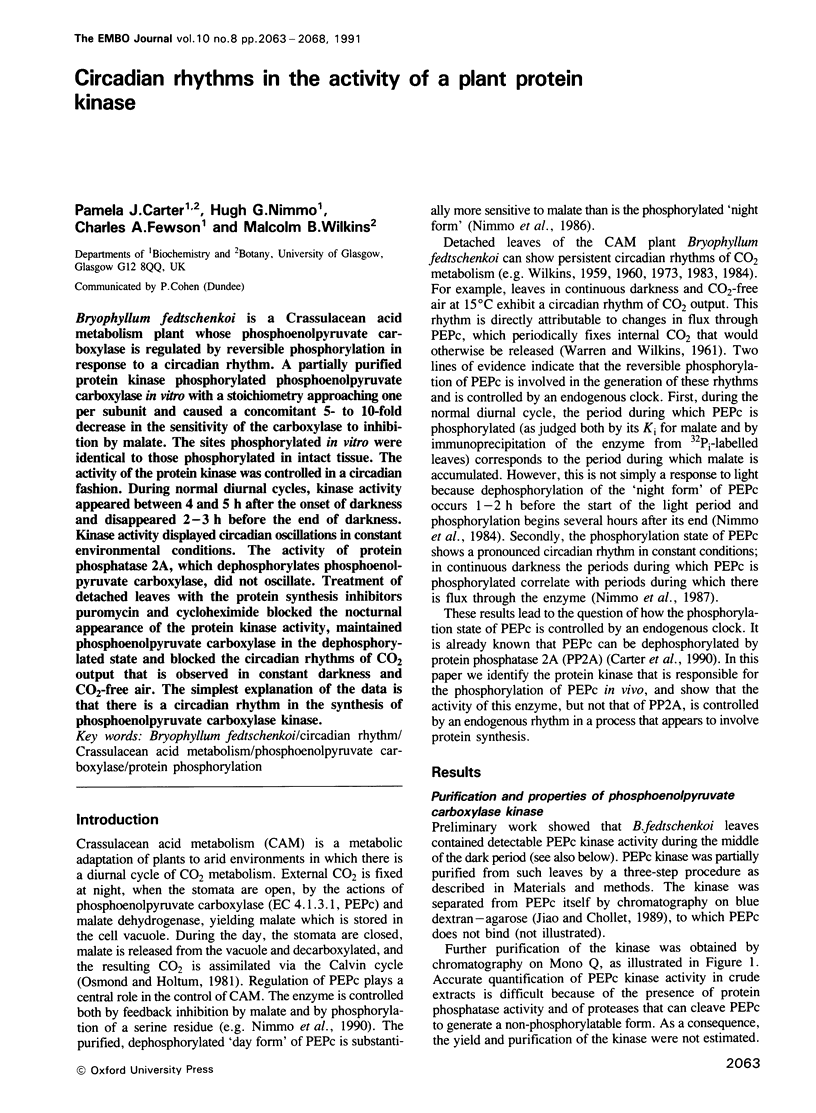
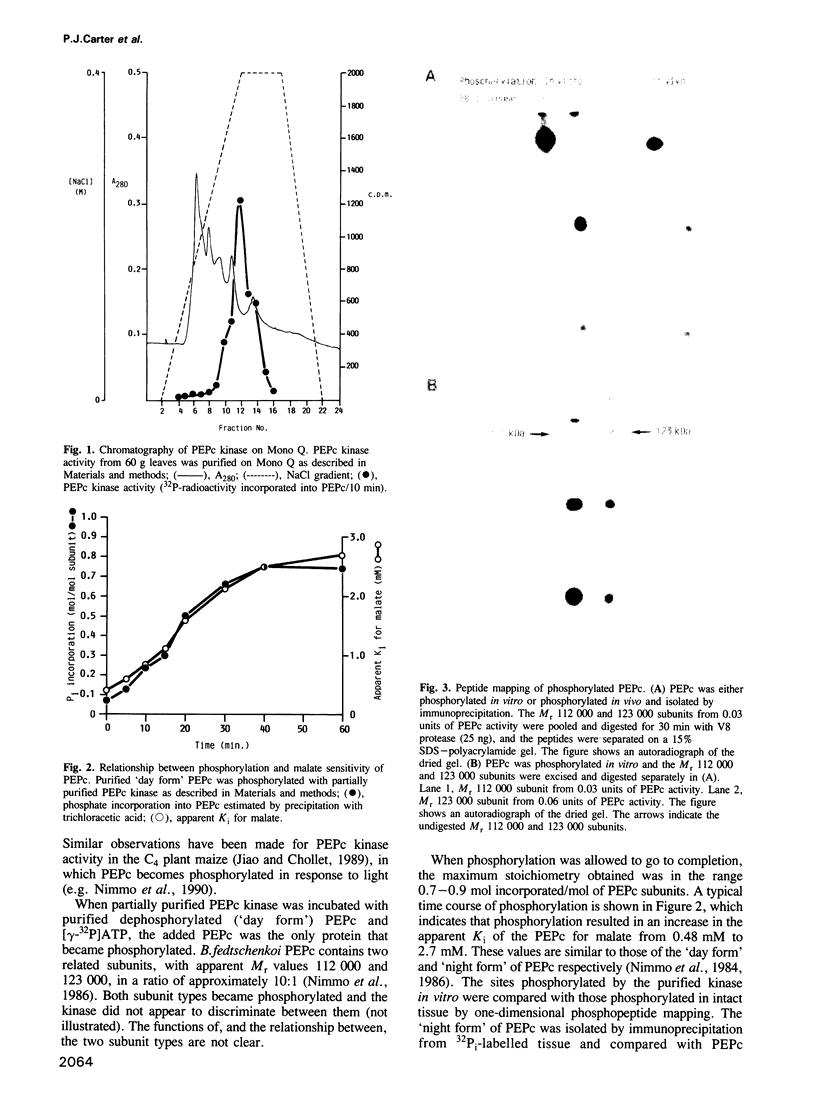
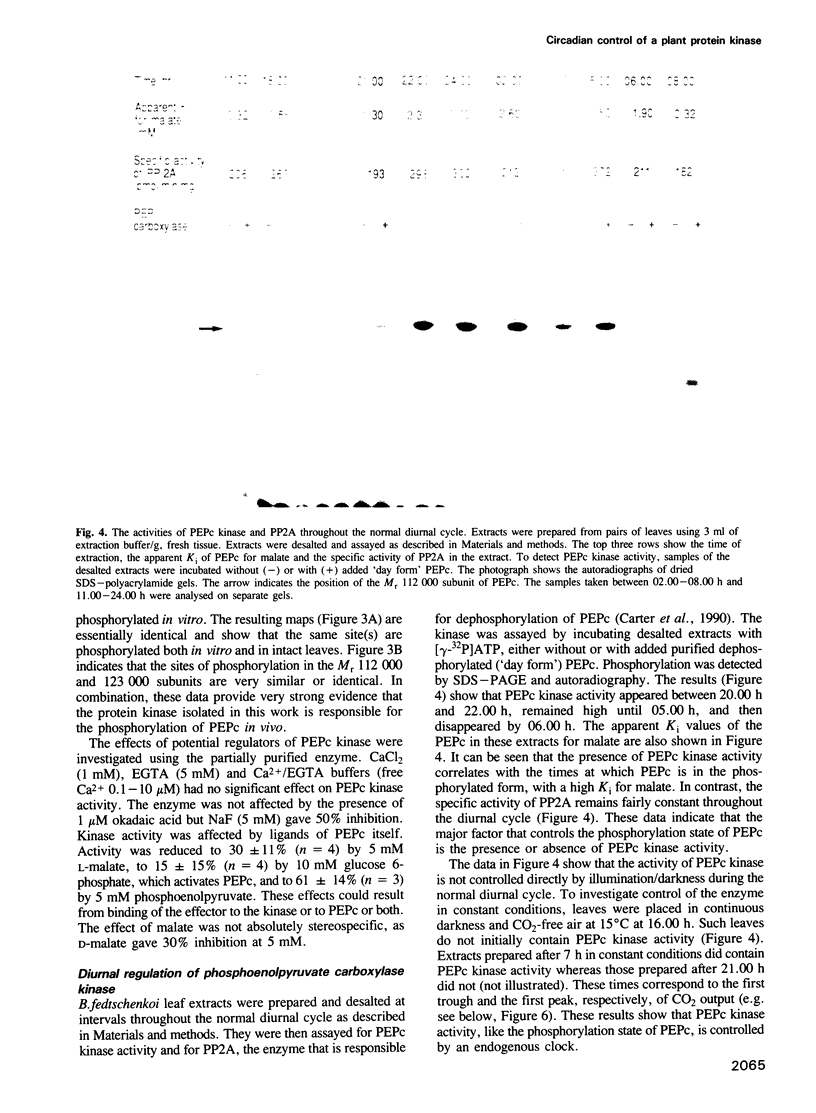
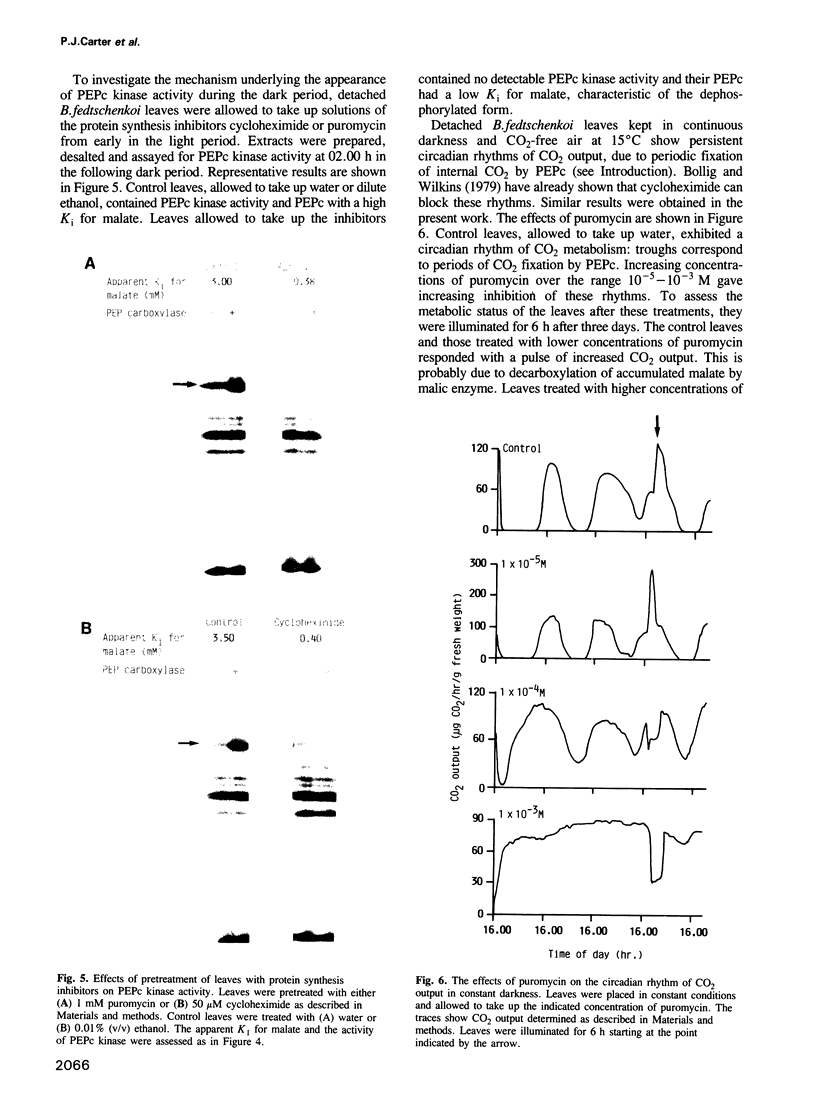
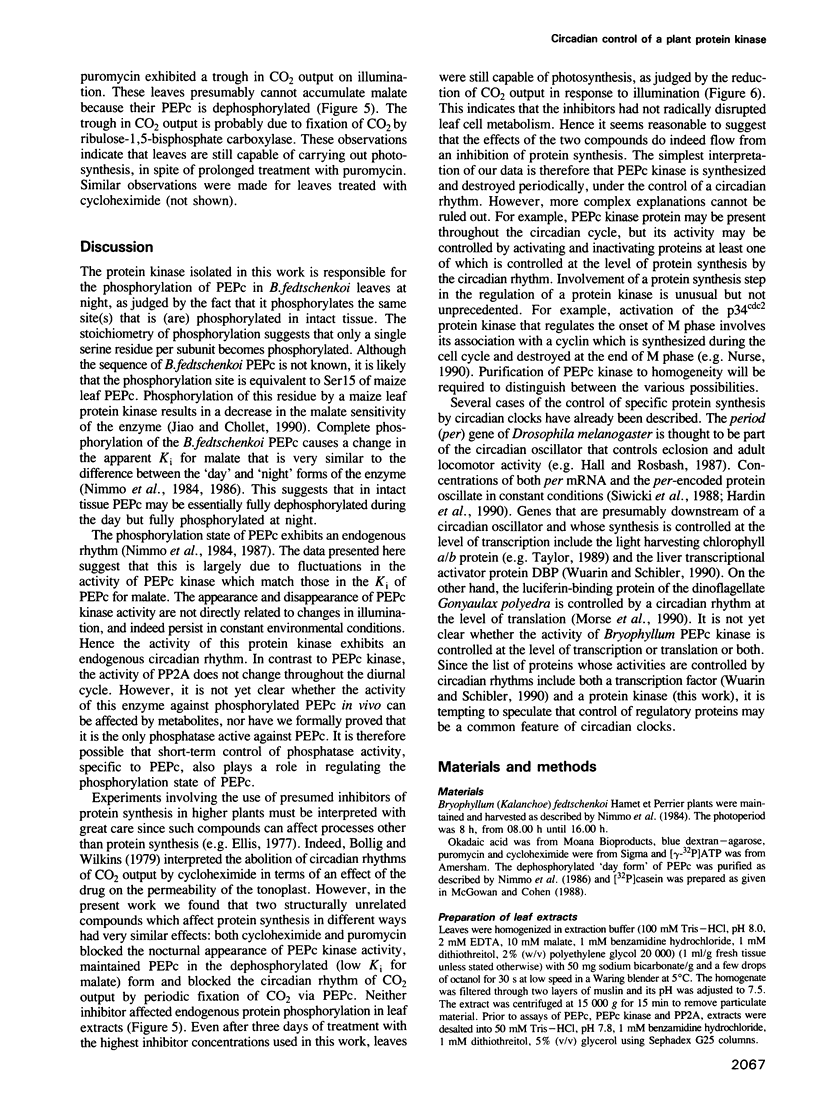
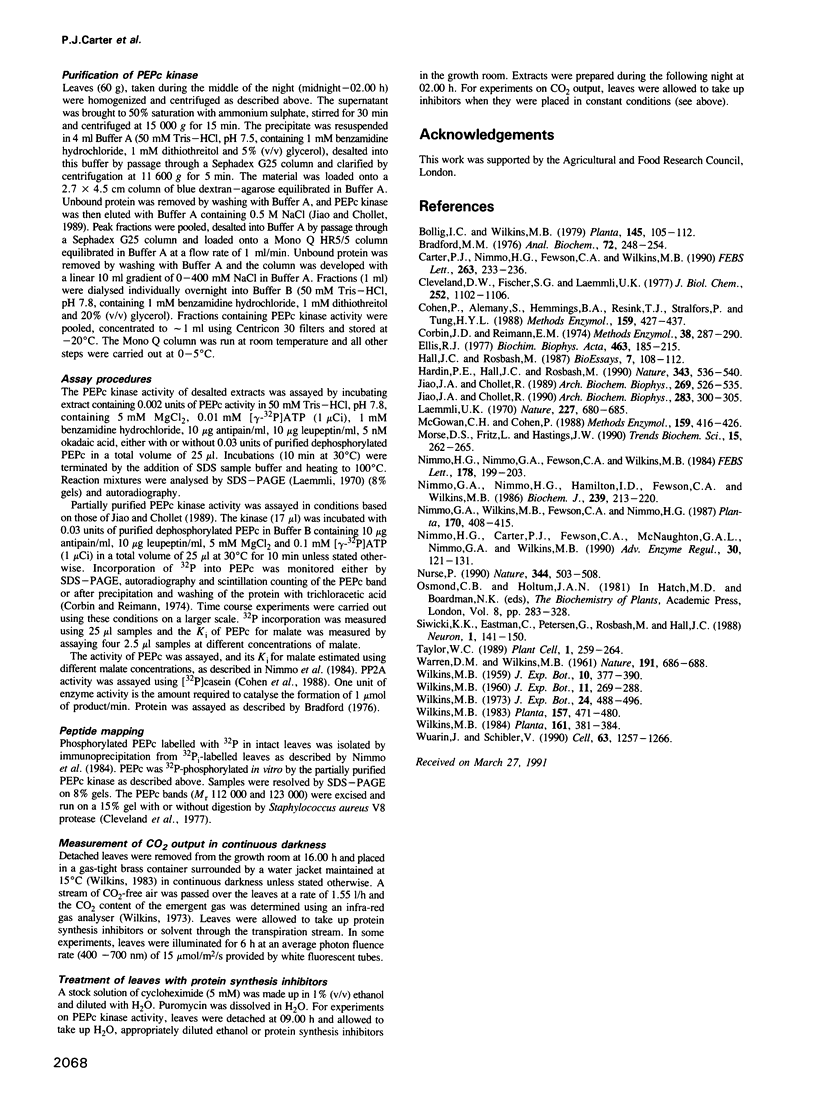
Images in this article
Selected References
These references are in PubMed. This may not be the complete list of references from this article.
- Bradford M. M. A rapid and sensitive method for the quantitation of microgram quantities of protein utilizing the principle of protein-dye binding. Anal Biochem. 1976 May 7;72:248–254. doi: 10.1006/abio.1976.9999. [DOI] [PubMed] [Google Scholar]
- Cleveland D. W., Fischer S. G., Kirschner M. W., Laemmli U. K. Peptide mapping by limited proteolysis in sodium dodecyl sulfate and analysis by gel electrophoresis. J Biol Chem. 1977 Feb 10;252(3):1102–1106. [PubMed] [Google Scholar]
- Cohen P., Foulkes J. G., Holmes C. F., Nimmo G. A., Tonks N. K. Protein phosphatase inhibitor-1 and inhibitor-2 from rabbit skeletal muscle. Methods Enzymol. 1988;159:427–437. doi: 10.1016/0076-6879(88)59042-0. [DOI] [PubMed] [Google Scholar]
- Corbin J. D., Reimann E. M. Assay of cyclic AMP-dependent protein kinases. Methods Enzymol. 1974;38:287–290. doi: 10.1016/0076-6879(74)38044-5. [DOI] [PubMed] [Google Scholar]
- Hall J. C., Rosbash M. Genetics and molecular biology of rhythms. Bioessays. 1987 Sep;7(3):108–112. doi: 10.1002/bies.950070304. [DOI] [PubMed] [Google Scholar]
- Hardin P. E., Hall J. C., Rosbash M. Feedback of the Drosophila period gene product on circadian cycling of its messenger RNA levels. Nature. 1990 Feb 8;343(6258):536–540. doi: 10.1038/343536a0. [DOI] [PubMed] [Google Scholar]
- Jiao J. A., Chollet R. Regulatory phosphorylation of serine-15 in maize phosphoenolpyruvate carboxylase by a C4-leaf protein-serine kinase. Arch Biochem Biophys. 1990 Dec;283(2):300–305. doi: 10.1016/0003-9861(90)90646-g. [DOI] [PubMed] [Google Scholar]
- Jiao J. A., Chollet R. Regulatory seryl-phosphorylation of C4 phosphoenolpyruvate carboxylase by a soluble protein kinase from maize leaves. Arch Biochem Biophys. 1989 Mar;269(2):526–535. doi: 10.1016/0003-9861(89)90136-7. [DOI] [PubMed] [Google Scholar]
- Laemmli U. K. Cleavage of structural proteins during the assembly of the head of bacteriophage T4. Nature. 1970 Aug 15;227(5259):680–685. doi: 10.1038/227680a0. [DOI] [PubMed] [Google Scholar]
- McGowan C. H., Cohen P. Protein phosphatase-2C from rabbit skeletal muscle and liver: an Mg2+-dependent enzyme. Methods Enzymol. 1988;159:416–426. doi: 10.1016/0076-6879(88)59041-9. [DOI] [PubMed] [Google Scholar]
- Morse D. S., Fritz L., Hastings J. W. What is the clock? Translational regulation of circadian bioluminescence. Trends Biochem Sci. 1990 Jul;15(7):262–265. doi: 10.1016/0968-0004(90)90050-l. [DOI] [PubMed] [Google Scholar]
- Nimmo G. A., Nimmo H. G., Hamilton I. D., Fewson C. A., Wilkins M. B. Purification of the phosphorylated night form and dephosphorylated day form of phosphoenolpyruvate carboxylase from Bryophyllum fedtschenkoi. Biochem J. 1986 Oct 1;239(1):213–220. doi: 10.1042/bj2390213. [DOI] [PMC free article] [PubMed] [Google Scholar]
- Nimmo H. G., Carter P. J., Fewson C. A., McNaughton G. A., Nimmo G. A., Wilkins M. B. Regulation of phosphoenolpyruvate carboxylase: an example of signal transduction via protein phosphorylation in higher plants. Adv Enzyme Regul. 1990;30:121–131. doi: 10.1016/0065-2571(90)90013-r. [DOI] [PubMed] [Google Scholar]
- Nurse P. Universal control mechanism regulating onset of M-phase. Nature. 1990 Apr 5;344(6266):503–508. doi: 10.1038/344503a0. [DOI] [PubMed] [Google Scholar]
- Siwicki K. K., Eastman C., Petersen G., Rosbash M., Hall J. C. Antibodies to the period gene product of Drosophila reveal diverse tissue distribution and rhythmic changes in the visual system. Neuron. 1988 Apr;1(2):141–150. doi: 10.1016/0896-6273(88)90198-5. [DOI] [PubMed] [Google Scholar]
- Taylor W. C. Transcriptional regulation by a circadian rhythm. Plant Cell. 1989 Feb;1(2):259–264. doi: 10.1105/tpc.1.2.259. [DOI] [PMC free article] [PubMed] [Google Scholar]
- Wuarin J., Schibler U. Expression of the liver-enriched transcriptional activator protein DBP follows a stringent circadian rhythm. Cell. 1990 Dec 21;63(6):1257–1266. doi: 10.1016/0092-8674(90)90421-a. [DOI] [PubMed] [Google Scholar]





